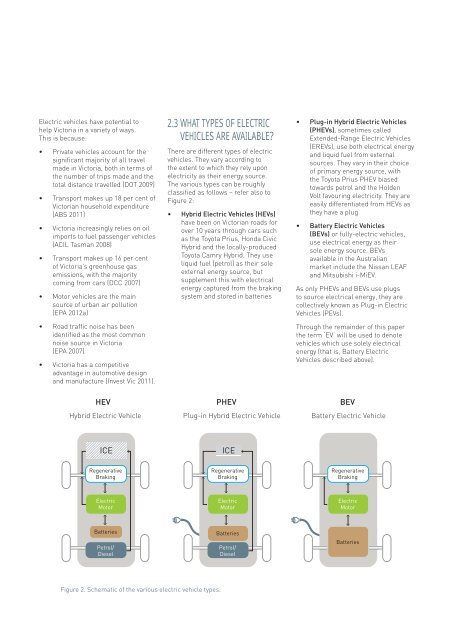victorian electric vehicle trial mid-term report - Department of Transport
victorian electric vehicle trial mid-term report - Department of Transport
victorian electric vehicle trial mid-term report - Department of Transport
- No tags were found...
You also want an ePaper? Increase the reach of your titles
YUMPU automatically turns print PDFs into web optimized ePapers that Google loves.
Electric <strong>vehicle</strong>s have potential tohelp Victoria in a variety <strong>of</strong> ways.This is because:• Private <strong>vehicle</strong>s account for thesignificant majority <strong>of</strong> all travelmade in Victoria, both in <strong>term</strong>s <strong>of</strong>the number <strong>of</strong> trips made and thetotal distance travelled (DOT 2009)• <strong>Transport</strong> makes up 18 per cent <strong>of</strong>Victorian household expenditure(ABS 2011)• Victoria increasingly relies on oilimports to fuel passenger <strong>vehicle</strong>s(ACIL Tasman 2008)• <strong>Transport</strong> makes up 16 per cent<strong>of</strong> Victoria’s greenhouse gasemissions, with the majoritycoming from cars (DCC 2007)• Motor <strong>vehicle</strong>s are the mainsource <strong>of</strong> urban air pollution(EPA 2012a)• Road traffic noise has beenidentified as the most commonnoise source in Victoria(EPA 2007)• Victoria has a competitiveadvantage in automotive designand manufacture (Invest Vic 2011).2.3 WHAT TYPES OF ELECTRICVEHICLES ARE AVAILABLE?There are different types <strong>of</strong> <strong>electric</strong><strong>vehicle</strong>s. They vary according tothe extent to which they rely upon<strong>electric</strong>ity as their energy source.The various types can be roughlyclassified as follows – refer also toFigure 2:• Hybrid Electric Vehicles (HEVs)have been on Victorian roads forover 10 years through cars suchas the Toyota Prius, Honda CivicHybrid and the locally-producedToyota Camry Hybrid. They useliquid fuel (petrol) as their soleexternal energy source, butsupplement this with <strong>electric</strong>alenergy captured from the brakingsystem and stored in batteries• Plug-in Hybrid Electric Vehicles(PHEVs), sometimes calledExtended-Range Electric Vehicles(EREVs), use both <strong>electric</strong>al energyand liquid fuel from externalsources. They vary in their choice<strong>of</strong> primary energy source, withthe Toyota Prius PHEV biasedtowards petrol and the HoldenVolt favouring <strong>electric</strong>ity. They areeasily differentiated from HEVs asthey have a plug• Battery Electric Vehicles(BEVs) or fully-<strong>electric</strong> <strong>vehicle</strong>s,use <strong>electric</strong>al energy as theirsole energy source. BEVsavailable in the Australianmarket include the Nissan LEAFand Mitsubishi i-MiEV.As only PHEVs and BEVs use plugsto source <strong>electric</strong>al energy, they arecollectively known as Plug-in ElectricVehicles (PEVs).Through the remainder <strong>of</strong> this paperthe <strong>term</strong> ‘EV’ will be used to denote<strong>vehicle</strong>s which use solely <strong>electric</strong>alenergy (that is, Battery ElectricVehicles described above).HEV PHEV BEVHybrid Electric Vehicle Plug-in Hybrid Electric Vehicle Battery Electric VehicleICEICERegenerativeBrakingRegenerativeBrakingRegenerativeBrakingElectricMotorElectricMotorElectricMotorBatteriesPetrol/DieselBatteriesPetrol/DieselBatteriesFigure 2. Schematic <strong>of</strong> the various <strong>electric</strong> <strong>vehicle</strong> types.
















